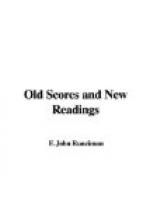work sung instead of simply having it printed as an
antiquarian curiosity. The music does not suggest
the eighteenth century with its jangling harpsichords,
its narrow, dirty streets, its artificiality, its
brilliant candle-lighted rooms where the wits and
great ladies assembled and talked more or less naughtily.
There is indeed a strange, pathetic charm in the eighteenth
century to which no one can be indifferent: it
is a dead century, with the dust upon it, and yet
a faint lingering aroma as of dead rose petals.
But the old-world atmosphere of Byrde’s music
is, at least to me, something finer than that:
it is the atmosphere of a world which still lives:
it is remote from us and yet very near: for the
odour of dead rose petals and dust you have a calm
cool air, and a sense of fragrant climbing flowers
and of the shade of full foliaged trees. All
is sane, clean, fresh: one feels that the sun
must always have shone in those days. This quality,
however, it shares with a great deal of the music
of the “spacious days” of Elizabeth.
But of its expressiveness there is not too much to
be found in the music of other musicians than Byrde
in Byrde’s day. He towered high above all
the composers who had been before him; he stands higher
than any other English musician who has lived since,
with the exception of Purcell. It is foolish
to think of comparing his genius with the genius of
Palestrina; but the two men will also be reckoned close
together by those who know this Mass and the Cantiones
Sacrae. They were both consummate masters of
the technique of their art; they both had a fund of
deep and original emotion; they both knew how to express
it through their music. I have not space to mention
all the examples I could wish. But every reader
of this article may be strongly recommended at once
to play, even on the piano, the sublime passage beginning
at the words “Qui propter nos homines,”
noting more especially the magnificent effect of the
swelling mass of sound dissolving in a cadence at
the “Crucifixus.” Another passage,
equal to any ever written, begins at “Et unam
Sanctam Catholicam.” There is a curious
energy in the repetition of “Et Apostolicam Ecclesiam,”
and then a wistful sweetness and tenderness at “Confiteor
unum baptisma.” Again, the whole of the
“Agnus” is divine, the repeated “miserere
nobis,” and the passage beginning at the “Dona
nobis pacem,” possessing that sweetness, tenderness
and wonderful calm. But there is not a number
that does not contain passages which one must rank
amongst the greatest things in the world; and it must
be borne in mind that these passages are not detached,
nor in fact detachable, but integral, essential parts
of a fine architectural scheme.




